Missing Craters on Ceres

Shown north down in this false-color image, Ceres has many craters, but few large ones. Its largest is Kerwan (280 km wide), the rims (red-yellow) and central depression (blue) of which are clear in this topographic map. Beneath Kerwan hides an 800-km-wide, 4-km-deep depression (in green) called Vendimia Planitia. This depression is possibly what’s left of one of the largest craters from Ceres’s earliest collisional history.
Simone Marchi / SWRI
Ceres is the largest body in the asteroid belt. It spans about 940 km (580 miles), more than half again as big as one of the next largest asteroids, Vesta (525 km/326 mi). Over the course of the solar system’s 4½ billion years, these bodies have received an almighty pummeling from rocks and comets, leaving their surfaces battle-scarred.
But, as Simone Marchi (Southwest Research Institute) and others report July 26th in Nature Communications, when it comes to big craters Ceres is strangely smooth.
Vesta, which NASA’s Dawn spacecraft visited before it arrived at Ceres in 2015, has a devastated-looking surface. Its largest crater (Rheasilvia) is nearly as wide as the asteroid itself. Planetary scientists estimated that Ceres would also look ragged, with roughly a dozen craters bigger than 400 km. Yet its largest crater, Kerwan, spans only 280 km. And of the 40-plus pockmarks the dwarf planet “should” have that are larger than 100 kilometers, it has only 16.
Ceres does, however, have a bunch of smaller craters — so many that in some areas the surface is saturated with them, meaning that for every new crater created, another one is erased. These could hide older, larger structures.
And in fact the team has now found the echo of an 800-km-wide crater: the low-lying Vendimia Planitia, hidden to the eye but apparent (barely) in a topographic map. Kerwan lies within its southern edge. The putative basin also looks distinctly different in terms of chemical makeup than the rest of Ceres, suggesting the impact might have excavated stuff with a different composition or triggered its creation when the body hit.
Even with that finding, though, there still aren’t enough large craters to satisfy scientists — it’s very difficult to explain why there are so few in the 100- to 400-km range.
The solution is that Ceres has likely erased its scars with time. This process could have happened a couple of ways. Recent analysis by the Dawn team suggests the dwarf planet’s subsurface is 30% to 40% ice by volume. Without a rigid rock makeup, Ceres’s surface would relax over time, like skin does after you press it hard with your fingertip. This relaxation would slowly obliterate craters. And since big craters happened more often in the solar system’s early history — when more big hunks of rock were flying around — those would be more faded relative to smaller ones.
Another possibility is that ice volcanism resurfaced Ceres. The infamous bright spots in the crater Occator and elsewhere are salt deposits, and they may have been left there by water rising from below and then evaporating away. If so, then this world was geologically active (maybe it still is?) and could have remade its façade.
No comments:
Post a Comment